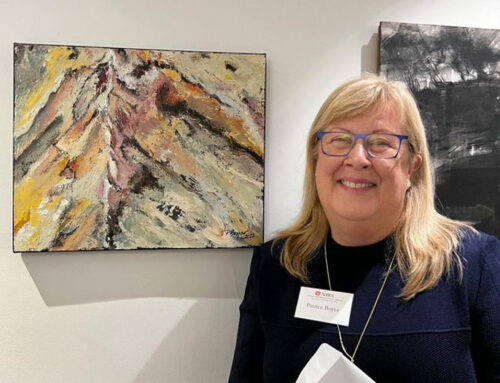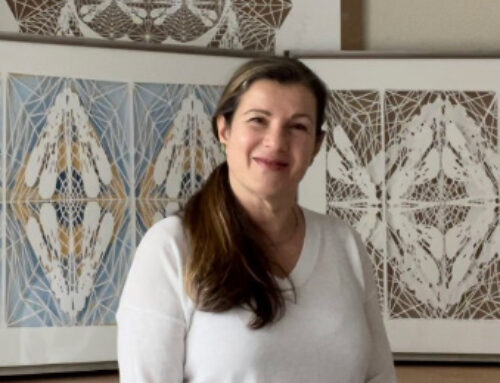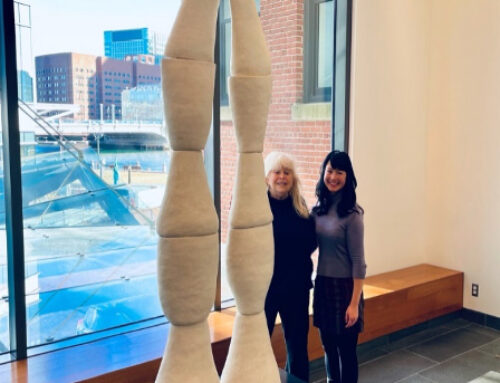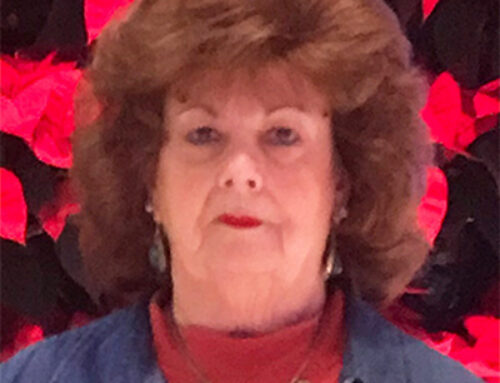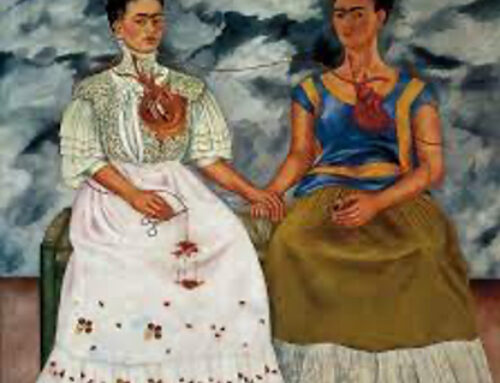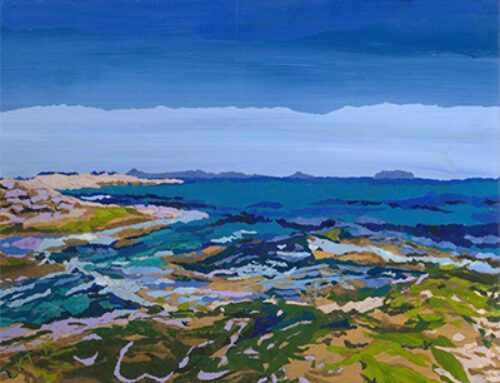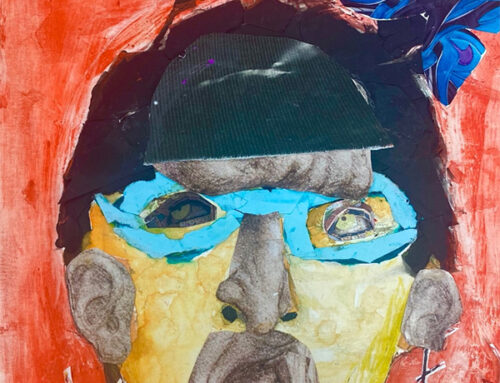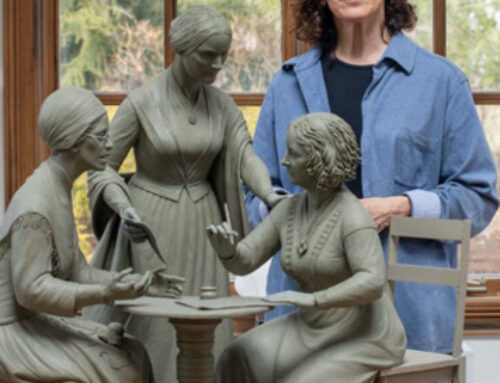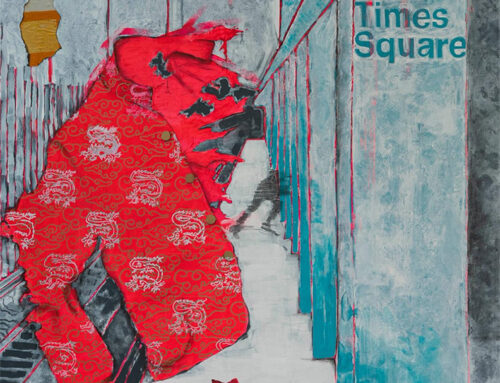Méret Oppenheim: My Exhibition
By Sandra Bertrand

Breakfast in Fur, a 1936 sculpture by the surrealist Méret Oppenheim, consists of a fur-covered teacup, saucer and spoon.
Visiting the world of Méret Oppenheim is a little like confronting Object, her famed fur teacup—the viewer is tempted to imagine what’s underneath. It’s just an ordinary teacup, isn’t it? But is it? Such layers and layers of surprises await. The recent retrospective at MOMA, which closed on March 4, 2023,unearthed nearly 200 paintings, sculptures, assemblages, reliefs, jewelry designs, works on paper, and collages from a marvelously fluid mind.
At age 22, this remarkable Swiss-born artist managed to dazzle those mischievous, mostly male surrealists with that eponymous cup. The year was 1936 and her Object traveled from Paris to the United States for The Museum of Modern Art’s landmark exhibition, Fantastic Art, Dada, Surrealism. Over the next five decades, with her talent, persistence, and all-encompassing curiosity, she managed to produce a body of work that explored dreams, mythologies, the ambiguity of gender and the very nature of how we see.

Stone Woman, 1938
Imagine: A Stone Woman (1938) washed up on a shore. Her body a string of pebbles, artfully arranged, her human legs skirting the living surf. A painting but so much more. An early assemblage, Ma Gouvernante-My Nurse-Mein Kindermadchen (1967) displays a pair of high heels bound to a metal plate, a vulva-like shape attached, suggesting bondage. A nightmare version of Judy Chicago’s dinner plates?

Ma Gouvernante-My Nurse-Mein Kindermadchen, 1967

Daphne and Apollo, 1943
In Daphne and Apollo (1943) reimagined by the artist, Daphne has transformed herself into a laurel tree while Apollo is a pudgy suitor, little more than a clump of vegetation. The artist’s execution could easily rival contemporaries like Max Ernst or Salvador Dali.
Later works show an easy embrace of materials, such as Profile (1964) where oil, chalk, molded substance and glass marble, the latter creating a mesmerizing eye, greet the viewer. There She Flies, the Beloved (1975) reconciles the male and female aspects of the self. In 1975, Oppenheim summed it all up accordingly, “Nobody will give you freedom. You have to take it.”
What If Women Ruled the World?
 Judy Chicago and Nadya Tolokonnikova invite you to join this participatory artwork, support gender equality and create change. All who share feminist values are invited to come together and make their voices heard at this urgent time for women’s rights.
Judy Chicago and Nadya Tolokonnikova invite you to join this participatory artwork, support gender equality and create change. All who share feminist values are invited to come together and make their voices heard at this urgent time for women’s rights.
Choose a single question or respond to as many questions as you want from the list on their website. Written messages and visual images submitted to whatifwomenruledtheworld.com will be reviewed and selected contributions will be shaped by the artists into a new collaborative project, with the mission of creating a foundation for the largest gender rights community in Web3. (Web3 is an umbrella term for an internet with added identity, money and social layer.)
This project took Chicago’s inspiring banners What If Women Ruled the World, which were created in collaboration with Dior Creative Director Maria Grazia Chiuri for the Dior Spring 2020 Haute Couture show in Paris, as its source for a new revolutionary blockchain enabled call-and-response.
Judy Chicago is the founder of the first Feminist Art Program at Fresno State, CA. For more about her work, visit: judychicago.com
Tolokonnikova is a Russian-born conceptual artist, political activist, musician and the founding member of Pussy Riot, a global feminist protest art movement. She was sentenced to two years in prison following an anti-Putin performance, ultimately being sent to a Siberian penal colony. For more information, go to pussyriot.love.
Artist Maya Lin Honored with 29th Annual Crystal Award
The artist and architect was honored with the 29th edition of the award, which recognizes cultural leaders, at the opening of the World Economic Forum’s 2023 annual meeting in Davos, Switzerland. In her acceptance speech, Lin spoke about the power of art to make a tangible impact on combating climate change.
Through her work, Lin has been committed to focusing attention on key issues of our time. She is best known as the architect of the world-renowned Vietnam Veterans Memorial in Washington, D.C. At that time, the memorial was intensely controversial both for the cultural origin and the young age of the artist.
Lin works from a studio in New York and has gone on to other public art installations, including the Civil Rights Memorial in Montgomery, Alabama. She was the recipient of the Presidential Medal of Freedom in 2016.
Lin’s latest memorial, What is Missing?, is experimental and multi-disciplinary in nature. Through her work, Lin raises awareness of the present mass extinctions of species, while emphasizing the importance of reforming our land use practices to reduce emissions and restore and protect biodiversity.



